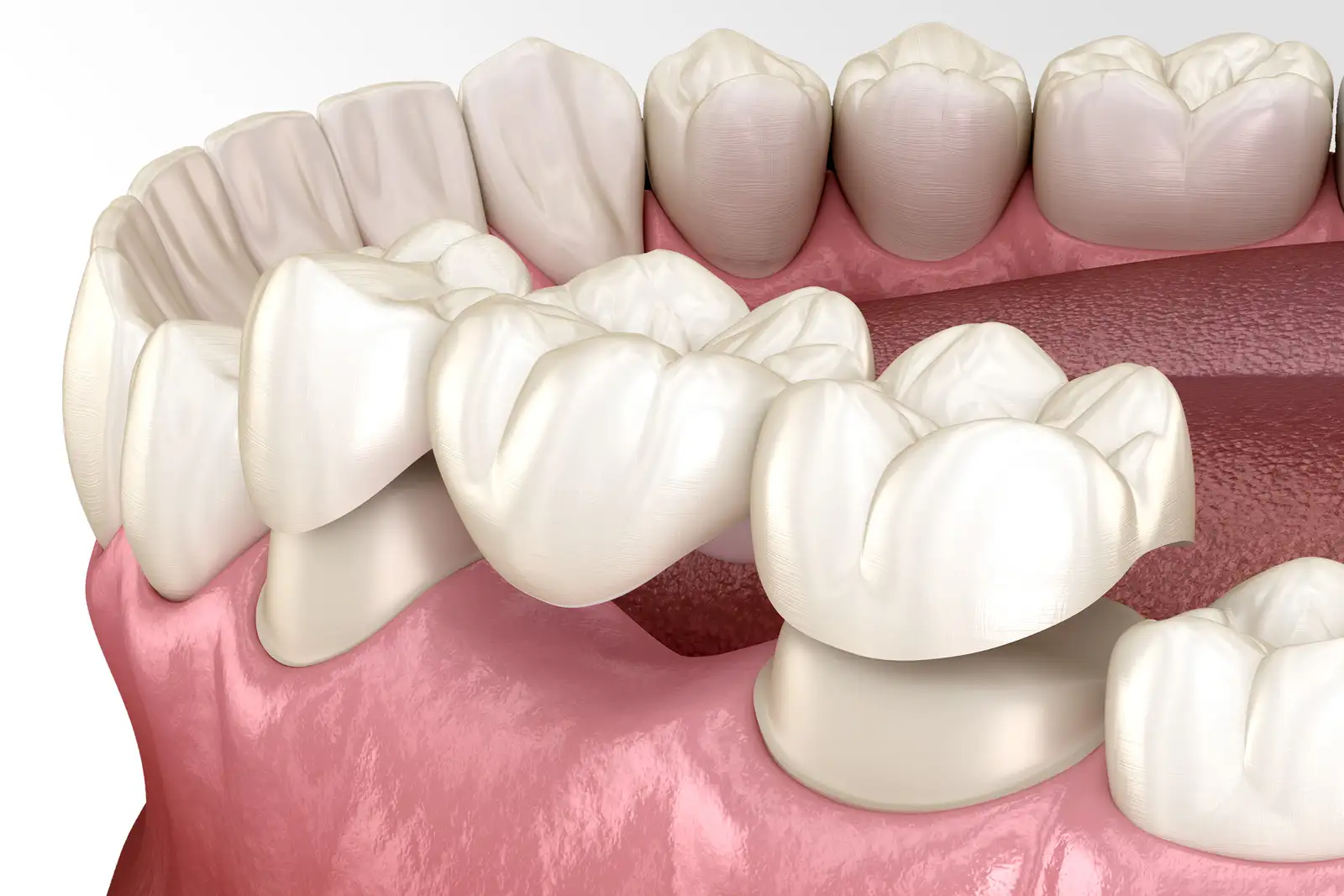Bridge on natural teeth
A bridge on natural teeth effectively replaces a series of missing, heavily damaged, or aesthetically unsuitable teeth by relying on healthy adjacent teeth as supports, without the need for implant placement.

A dental bridge is permanently fixed and is a stable dental solution that also ensures the stability and natural appearance of the dental arch.
What is a bridge on natural teeth?
A bridge on natural teeth is a fixed prosthetic solution used to replace one or more missing teeth. In the case of a single missing tooth, the bridge is supported by healthy natural teeth, which act as abutments, while an artificial tooth (pontic) is positioned between them to replace the missing one.
A bridge can be made of several units and is also used in cases of multiple damaged or missing teeth.
Advantages of a bridge on natural teeth
- Fixed solution – does not move and feels like natural teeth
- Aesthetically natural appearance – matches the color and shape of existing teeth
- Provides stability and enables comfortable chewing and speaking
- Prevents shifting of neighboring teeth into the empty space
- Long-lasting – can last 10–15 years with proper oral hygiene
Who are candidates for a bridge on natural teeth?
A bridge on natural teeth is an ideal solution for patients who:
- Have one or more missing teeth in a row
- Have healthy adjacent teeth that can serve as bridge supports
- Prefer a fixed dental solution
- Want to aesthetically improve their smile and restore tooth function
- Do not have sufficient bone for implant placement or prefer to avoid surgical procedures
For a bridge to be durable, the abutment teeth (adjacent teeth) must be healthy and strong enough to withstand additional load.
Procedure for placing a dental bridge
The placement of a bridge on natural teeth typically takes place over several appointments to ensure optimal stability and aesthetics.
1. First visit – Examination and therapy planning
- Clinical examination of the oral cavity
- Diagnostic procedures to assess the condition of the roots and bone of the abutments (adjacent teeth)
- Selection of the bridge material and color according to the patient’s aesthetic and functional needs
2. Second visit – Preparation of natural teeth (abutments) and placement of a temporary bridge
- Preparation of natural teeth that will serve as abutments
- Taking precise impressions of the jaw for bridge fabrication
- Placement of a temporary bridge that protects the prepared teeth and maintains functionality until the permanent bridge is ready
3. Third visit – Placement of the permanent bridge
- Removal of the temporary bridge and placement of the permanent one
- Checking the fit, aesthetics, and bite
- Once both the patient and dentist confirm the bridge fits perfectly, it is permanently cemented
A bridge on natural teeth is an effective and long-term prosthetic solution for replacing lost or damaged teeth, offering patients a fixed option without the need for implant placement.
Precisely crafted bridges made of ceramic, zirconia-ceramic, or metal-ceramic ensure the highest level of aesthetics, functionality, and a natural tooth-like appearance.
This method enables normal chewing and speaking functions, maintains proper tooth alignment, and preserves facial structure.
For longevity and valid warranties, regular oral hygiene and dental visits are essential.
Frequently asked questions and answers about bridges on natural teeth
The process usually takes between one and three weeks, depending on the number of teeth and required adjustments.
No, the procedure is performed under local anesthesia, so the patient does not feel pain during tooth preparation and bridge placement.
Zirconia and ceramic provide the best aesthetics and longevity, while metal-ceramic bridges are more durable and cost-effective.
With proper oral hygiene and regular check-ups, a bridge can last 10–15 years or even longer.
A bridge is maintained just like natural teeth – regular brushing, using dental floss and interdental brushes, and regular dental check-ups.
Although bridges are made from very durable materials, excessive force (e.g., biting hard foods) can cause cracks or bridge loosening.
Yes, modern dental materials allow for bridges that fully mimic the color and shape of natural teeth.
If an abutment (natural tooth) is damaged or lost, the bridge usually needs to be replaced or adapted to a new dental solution.
The cost varies depending on the material and number of bridge units, so it’s best to consult a dentist for an exact quote.
A bridge is a faster and more economical solution, while implants are longer-lasting and do not require the preparation of neighboring teeth.
Contact us
Our friendly team will be happy to listen to your requests.
